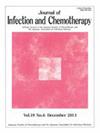使用脉冲氙气紫外线能降低医疗相关感染的风险吗?最新的系统综述和荟萃分析
IF 1.5
4区 医学
Q3 INFECTIOUS DISEASES
引用次数: 0
摘要
目的评价脉冲氙气紫外线系统(PX-UVL)降低医疗相关感染(HAI)的能力。方法纳入PubMed、Embase、Scopus和Web of Science数据库中截至2025年2月25日发表的评估使用PX-UVL的HAI风险的所有类型的研究。收集艰难梭菌感染(CDI)、耐甲氧西林金黄色葡萄球菌(MRSA)感染、耐万古霉素肠球菌(VRE)感染和鲍曼不动杆菌感染(ABI)的数据。结果共纳入14项研究。大多数研究采用前后研究设计,其中两项为对照试验。荟萃分析显示,PX-UVL可显著降低CDI的风险(RR: 0.76 95% CI: 0.59, 0.97 I2 = 72%)。然而,结果仅在前后研究中具有显著性(RR: 0.75 95% CI: 0.57, 0.98 I2 = 73%),而在对照试验中无显著性(RR: 0.70 95% CI: 0.25, 1.96 I2 = 72%)。敏感性分析结果也不稳定。meta分析也显示MRSA感染有减少的趋势,但效应量无统计学意义(RR: 0.80 95% CI: 0.62, 1.02 I2 = 65%)。合并分析显示,PX-UVL对降低VRE感染风险无显著影响(RR: 0.83 95% CI: 0.66, 1.04 I2 = 54%)或ABI (RR: 0.64 95% CI: 0.21, 1.90 I2 = 96%)。基于研究设计的亚组分析显示,在前后研究和对照试验中,VRE感染的风险均未发生变化。结论目前来自不同研究设计的证据表明,PX-UVL可能对降低HAI的疗效有限。进一步的高质量随机对照试验将提供高质量的证据。本文章由计算机程序翻译,如有差异,请以英文原文为准。
Does the use of pulsed-xenon ultraviolet light reduce the risk of healthcare-associated infections?: An updated systematic review and meta-analysis
Objective
The present review was conducted to assess the ability of the pulsed-xenon ultra-violet system (PX-UVL) to reduce healthcare-associated infections (HAI).
Methods
All types of studies available on PubMed, Embase, Scopus, and Web of Science databases assessing the risk of any HAI with the use of PX-UVL and published up to 25 February 2025 were included. Data on C. difficile infection (CDI), Methicillin-resistant Staphylococcus aureus (MRSA) infection, Vancomycin-resistant enterococci (VRE) infections, and Acinetobacter baumannii infections (ABI) was pooled.
Results
Fourteen studies were included. Most studies had a pre-post study design while two were controlled trials. Meta-analysis showed a statistically significant reduction in the risk of CDI with PX-UVL (RR: 0.76 95 % CI: 0.59, 0.97 I2 = 72 %). However, results were significant only for pre-post studies (RR: 0.75 95 % CI: 0.57, 0.98 I2 = 73 %) but not for controlled trials (RR: 0.70 95 % CI: 0.25, 1.96 I2 = 72 %). The results were also not stable on sensitivity analysis. Meta-analysis also showed a tendency of reduction of MRSA infections but the effect size was statistically non-significant (RR: 0.80 95 % CI: 0.62, 1.02 I2 = 65 %). Pooled analysis demonstrated no significant impact of PX-UVL in reducing the risk of VRE infections (RR: 0.83 95 % CI: 0.66, 1.04 I2 = 54 %) or ABI (RR: 0.64 95 % CI: 0.21, 1.90 I2 = 96 %). Subgroup analysis based on study design showed that the risk of VRE infection did not change in both pre-post studies and controlled trials.
Conclusions
Current evidence from variable study designs suggests that PX-UVL may have limited efficacy in reducing HAI. Further high-quality randomized controlled trials will provide quality evidence.
求助全文
通过发布文献求助,成功后即可免费获取论文全文。
去求助
来源期刊

Journal of Infection and Chemotherapy
INFECTIOUS DISEASES-PHARMACOLOGY & PHARMACY
CiteScore
4.10
自引率
4.50%
发文量
303
审稿时长
47 days
期刊介绍:
The Journal of Infection and Chemotherapy (JIC) — official journal of the Japanese Society of Chemotherapy and The Japanese Association for Infectious Diseases — welcomes original papers, laboratory or clinical, as well as case reports, notes, committee reports, surveillance and guidelines from all parts of the world on all aspects of chemotherapy, covering the pathogenesis, diagnosis, treatment, and control of infection, including treatment with anticancer drugs. Experimental studies on animal models and pharmacokinetics, and reports on epidemiology and clinical trials are particularly welcome.
 求助内容:
求助内容: 应助结果提醒方式:
应助结果提醒方式:


